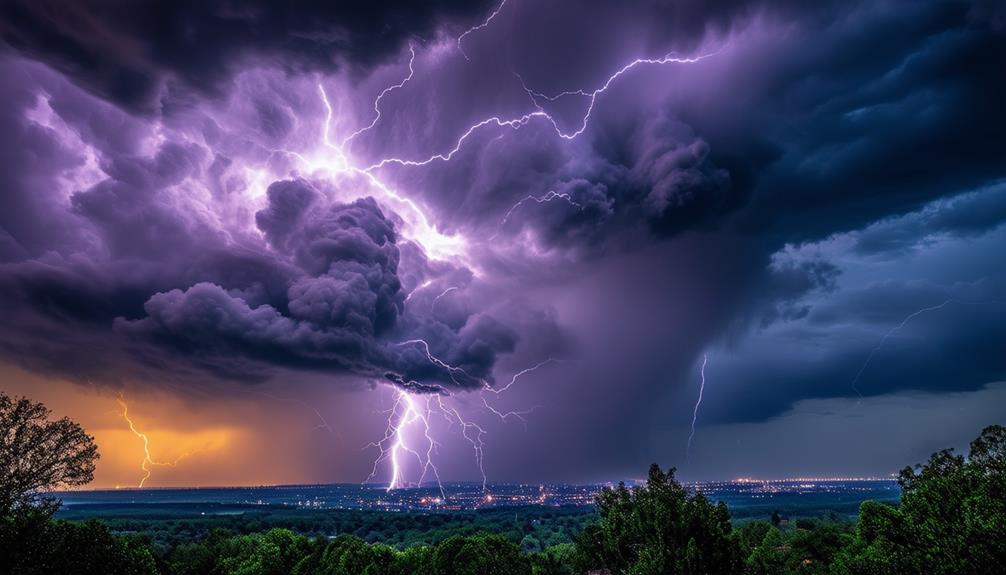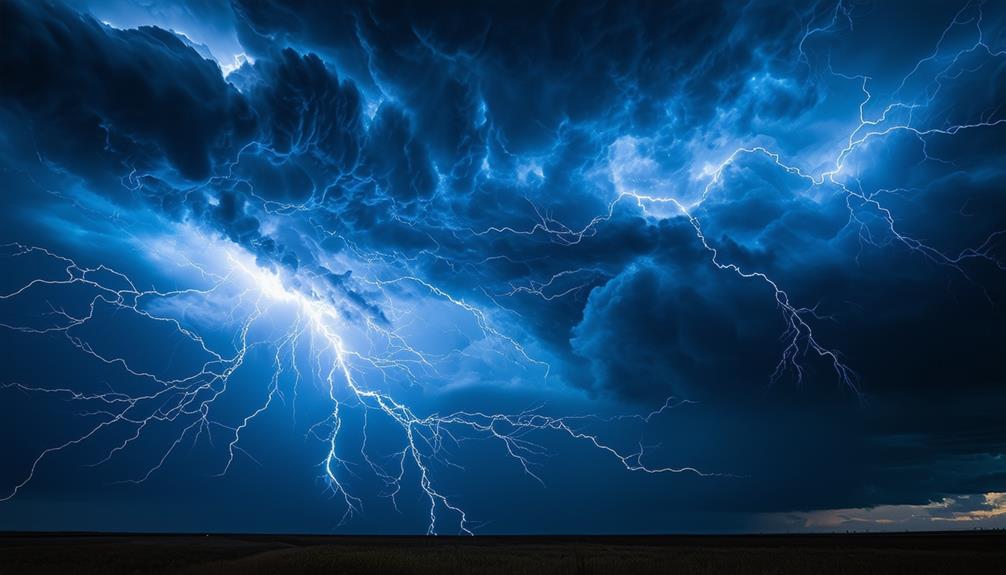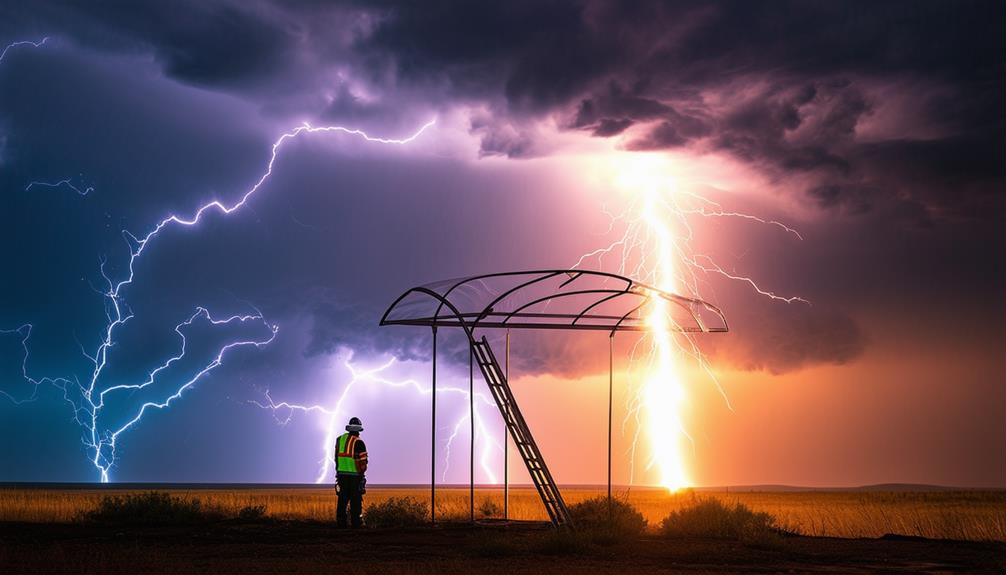The Physics of Lightning: Understanding Electrical Discharges in the Atmosphere

When you think about lightning, you likely envision a sudden, blinding flash across the sky, but there's far more happening behind the scenes. Lightning results from complex processes involving electrical discharges in the atmosphere, beginning with the buildup of electric fields in thunderclouds. These fields intensify until they can no longer be contained, leading to the dramatic discharge we recognize as lightning. But what triggers this buildup? And how do these discharges affect our weather patterns and safety measures? Let's explore these questions to understand the forces at play.
Lightning Statistics
Understanding lightning statistics is crucial for comprehending the full impact of this natural phenomenon. In the U.S. alone, lightning occurs about 25 million times annually, making it a significant weather-related hazard. While fatalities have decreased over the past 30 years, the risk of injury remains high. Injuries from lightning strikes can result in lifelong health issues, underscoring the importance of adhering to lightning safety measures.
Thunder can be heard from up to 10 miles away from a lightning strike, demonstrating the far-reaching impact of a thunderstorm. Additionally, lightning can heat the air to an astonishing 50,000 degrees Fahrenheit, which can cause severe burns and other injuries. This extreme heat further emphasizes the importance of understanding and practicing lightning safety.
Thunderstorm Development
Thunderstorm development begins when solar heating warms the air near the ground, causing it to rise. This ascending air forms cumulus clouds that grow vertically as the heating persists. Over time, these clouds can evolve into thunderstorms, characterized by precipitation and electrical discharges.
Heat-Driven Air Currents
When the sun heats the air near the ground, it initiates the formation of cumulus clouds and the potential development of thunderstorms. This process starts with heat-driven air currents. Warm air at the surface becomes less dense and rises, creating updrafts. As this air ascends, it encounters cooler air at higher altitudes, causing it to cool and condense into cumulus clouds.
These rising air currents are essential for thunderstorm development. Continuous surface heating sustains these updrafts, allowing the clouds to grow vertically. As cumulus clouds rise, they gather more moisture, eventually leading to precipitation within the storm cloud. This precipitation, in the form of raindrops, ice crystals, and hail, interacts and collides within the cloud, contributing to the separation of electrical charges.
Understanding heat-driven air currents is crucial for predicting thunderstorms and the associated risks. Recognizing how solar energy drives the early stages of thunderstorm formation helps anticipate conditions that lead to lightning and other severe weather phenomena. This knowledge is vital for improving safety measures and mitigating the impact of thunderstorms.
Cloud Formation Mechanism
As heat-driven air currents lift warm, moist air from the surface, updrafts form towering cumulus clouds, laying the foundation for thunderstorm development. This process begins when the sun heats the ground, causing the air to rise. As the air ascends, it cools and condenses into water droplets, creating cumulus clouds. With continued heating, these clouds grow vertically, evolving into larger thunderstorm clouds.
Within these developing thunderstorm clouds, various types of precipitation, such as rain, sleet, and hail, begin to form and interact. These interactions are crucial for the cloud's electrical charging process. When different precipitation types collide, they generate electrical charges. Ice crystals and water droplets exchange electrons, creating regions of positive and negative charges within the cloud. This charging process sets the stage for lightning discharges.
Understanding the intricacies of cloud formation and the interactions of precipitation types helps predict and assess the risks associated with thunderstorms. By comprehending these processes, one can better appreciate the complexity and power behind electrical discharges in the atmosphere.
Lightning Formation

To understand lightning formation, start by investigating how electric charges accumulate in storm clouds. Next, examine how an ionized pathway, or leader, develops, allowing charges to travel.
Charge Accumulation Process
During the development of a thunderstorm, cumulonimbus clouds actively gather electric charge essential for lightning formation. This process is driven by atmospheric physics, where interactions between particles within the cloud lead to charge separation. As the cloud grows, it transforms solar energy into mechanical and electrical energy, enhancing charge accumulation.
Here's a detailed breakdown of the process:
- Particle Collision: Ice crystals and water droplets within the cloud collide, resulting in electron transfer and charge separation.
- Updrafts and Downdrafts: Strong updrafts transport smaller, positively charged ice crystals to the top of the cloud, while heavier, negatively charged particles settle at the bottom.
- Charge Separation: This vertical separation creates a strong electric field between different regions of the cloud.
- Threshold Surpassing: The electric field intensifies until it surpasses the air's dielectric breakdown threshold, setting the stage for a lightning discharge.
- Energy Conversion: The cloud's mechanical movements convert solar energy into electrical energy, further intensifying the electric charge.
Understanding this charge accumulation process is crucial for grasping the initial phase of lightning formation. The electric charge builds up until the cloud's electric field reaches a critical point, leading to the spectacular discharges observed as lightning.
Lightning Pathway Development
Once an electric charge accumulates within a cloud, the next step in lightning formation is the creation of a conductive pathway through the atmosphere. This pathway, known as the lightning pathway, forms when the strong electric field between the cloud and the ground ionizes the air. The ionized air becomes plasma, making it highly conductive and capable of facilitating the transfer of charges. The lightning pathway develops in a series of steps called 'leaders.' These leaders create a stepped, jagged path as they extend downward from the cloud, seeking the path of least resistance.
As the leaders descend, they ionize more air, which continues to build and extend the pathway. Once a leader gets close enough to the ground or an object, it connects with an upward streamer from the ground, completing the conductive channel. This connection allows for rapid charge transfer, resulting in a visible lightning strike. Understanding this pathway development is essential, as it sets the stage for the eventual discharge mechanism, involving the high-energy pulses and currents characteristic of lightning.
Energy Release Mechanism
When the lightning pathway is fully established, a massive surge of electrical energy discharges rapidly through the conductive channel. This sudden release of energy is primarily due to the intense electric fields generated within cumulonimbus clouds. As these electric fields intensify, they eventually surpass the air's dielectric breakdown threshold, allowing ionized plasma channels to facilitate charge transfer.
During this process, several key phenomena occur:
- Electric Fields: The strength of the electric fields within cumulonimbus clouds determines the potential for a lightning strike.
- Charge Transfer: Ionized plasma channels enable the movement of charges between different regions in the cloud or between the cloud and the ground.
- High-Energy Current Pulses: Lightning discharges involve high-energy current pulses, which can reach tens or even hundreds of thousands of amperes.
- Energy Conversion: Cumulonimbus clouds act as giant heat engines, converting solar energy into mechanical and electrical energy.
- Dielectric Breakdown: When electric fields exceed the air's dielectric breakdown threshold, a conductive plasma channel forms, allowing lightning to occur.
The release of energy in a lightning strike is both immense and swift, often accompanied by a bright flash and thunder. Understanding these mechanisms helps elucidate how lightning forms and the tremendous forces at play during a strike.
Thunder and Lightning Distance
To estimate the distance of a lightning strike, count the seconds between the flash and the resulting thunderclap, then divide by five. This method works because sound travels approximately one mile every five seconds. For example, if you count 10 seconds from the flash to the thunder, the lightning strike occurred about 2 miles away.
Why does this happen? When lightning strikes, it heats the air to an astonishing 50,000 degrees Fahrenheit, causing rapid air expansion. This expansion creates a sound wave, which we hear as thunder. Thunder can be heard up to 10 miles away from the lightning strike.
Understanding the distance of a lightning strike isn't just interesting—it can be a useful safety measure. Knowing how far the storm is can help you assess whether you're in immediate danger or if you have time to seek shelter.
Hot Lightning and Safety Measures

Lightning's ability to heat the air to approximately 50,000 degrees Fahrenheit makes it a serious hazard that demands careful safety measures during thunderstorms. This extreme heat can cause severe injuries and even fatalities. The power of lightning should never be underestimated, and safety precautions are crucial.
To protect yourself and others during a thunderstorm, follow these essential safety measures:
- Seek shelter indoors: Move inside a sturdy building or a hard-topped vehicle when you hear thunder.
- Avoid electrical appliances: Steer clear of anything plugged into an electrical outlet, as lightning can cause power surges.
- Use cordless phones: Opt for cell phones instead of corded phones, which can conduct lightning.
- Avoid water: Refrain from bathing, showering, or washing dishes, as water pipes can conduct electricity.
- Stay away from windows and doors: Keep windows and doors closed to prevent lightning from striking through them.
Understanding thunderstorm development is vital for predicting lightning risks. By adhering to these safety measures, you significantly reduce your risk of injury from lightning. Remember, lightning is unpredictable, and respecting its power is key to staying safe.
High-Energy Phenomena
High-energy phenomena such as Runaway Electrons, X-rays, and Gamma Rays arise from the intense electrical activity within thunderclouds, resulting from complex charge transfer processes during lightning strikes. When hail particles and ice crystals collide, they create the high-energy conditions necessary for lightning and the subsequent production of high-energy particles.
During thunderstorms, you may observe transient luminous events (TLEs) like sprites, jets, and elves. These phenomena occur high above thunderclouds and are closely linked to the powerful electrical discharges below. TLEs not only provide visually stunning displays but are also critical for research into the electrical properties of the upper atmosphere.
Compact Cloud Discharges (CIDs) represent another fascinating aspect of high-energy phenomena. Although less understood, CIDs contribute to the complexity of atmospheric electrical discharges. By studying CIDs, scientists aim to gain deeper insights into the propagation of high-energy particles within clouds.
Conclusion
Understanding the physics of lightning involves comprehending the complex processes behind electrical discharges in thunderstorms. By learning how cumulonimbus clouds develop electric fields and eventually produce lightning, you can better predict storms and estimate strike distances.
Lightning's tremendous power underscores the significant conversions of solar energy within our atmosphere. Stay informed and safe, knowing that a deeper understanding of these phenomena can make a meaningful difference.




